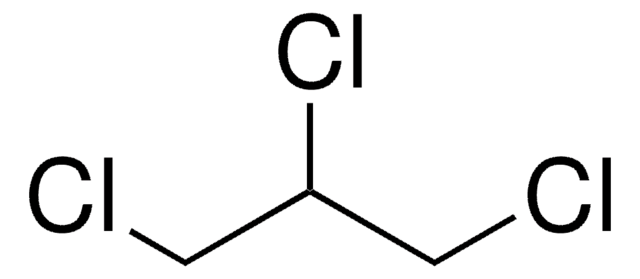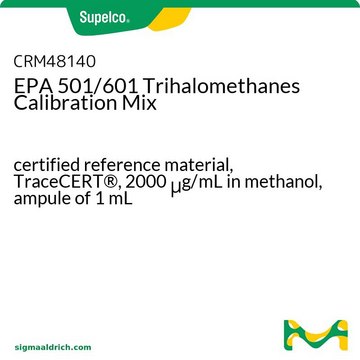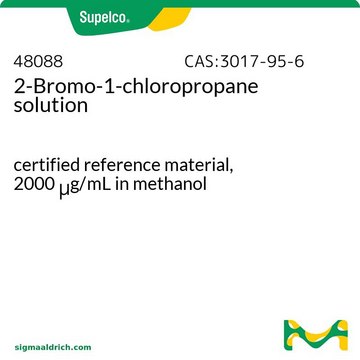Wichtige Dokumente
48355
1,2,3-Trichlorpropan -Lösung
certified reference material, 200 μg/mL in methanol
About This Item
Empfohlene Produkte
Qualität
certified reference material
TraceCERT®
Qualitätsniveau
Agentur
EPA 552
Produktlinie
TraceCERT®
Analysenzertifikat (CofA)
current certificate can be downloaded
Leistungsmerkmale
standard type internal
Verpackung
ampule of 1 mL
Konzentration
200 μg/mL in methanol
Methode(n)
HPLC: suitable
gas chromatography (GC): suitable
Anwendung(en)
cleaning products
cosmetics
environmental
food and beverages
personal care
Format
single component solution
Lagertemp.
2-8°C
SMILES String
ClC(CCl)CCl
InChI
1S/C3H5Cl3/c4-1-3(6)2-5/h3H,1-2H2
InChIKey
CFXQEHVMCRXUSD-UHFFFAOYSA-N
Suchen Sie nach ähnlichen Produkten? Aufrufen Leitfaden zum Produktvergleich
Anwendung
Sonstige Hinweise
Rechtliche Hinweise
Signalwort
Danger
H-Sätze
Gefahreneinstufungen
Acute Tox. 3 Dermal - Acute Tox. 3 Inhalation - Acute Tox. 3 Oral - Flam. Liq. 2 - STOT SE 1
Lagerklassenschlüssel
3 - Flammable liquids
WGK
WGK 1
Flammpunkt (°F)
51.8 °F
Flammpunkt (°C)
11 °C
Hier finden Sie alle aktuellen Versionen:
Analysenzertifikate (COA)
It looks like we've run into a problem, but you can still download Certificates of Analysis from our Dokumente section.
Wenn Sie Hilfe benötigen, wenden Sie sich bitte an Kundensupport
Besitzen Sie dieses Produkt bereits?
In der Dokumentenbibliothek finden Sie die Dokumentation zu den Produkten, die Sie kürzlich erworben haben.
Kunden haben sich ebenfalls angesehen
Protokolle
US EPA Method 8260: GC Analysis of Volatiles on SPB®-624 after Purge & Trap using "K" Trap, Fast GC Analysis
Unser Team von Wissenschaftlern verfügt über Erfahrung in allen Forschungsbereichen einschließlich Life Science, Materialwissenschaften, chemischer Synthese, Chromatographie, Analytik und vielen mehr..
Setzen Sie sich mit dem technischen Dienst in Verbindung.












